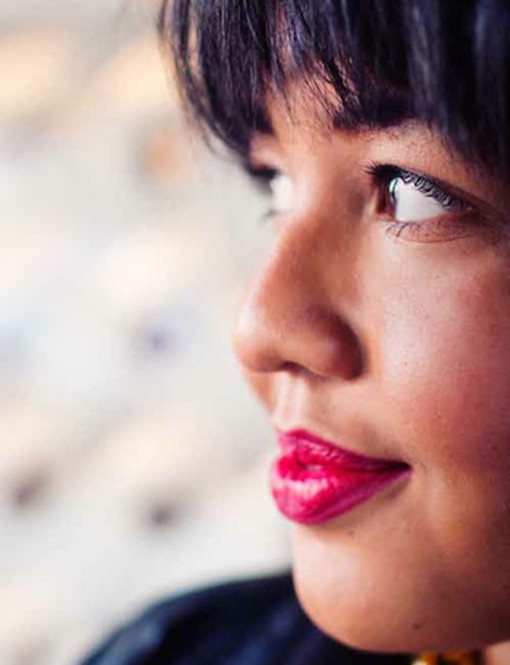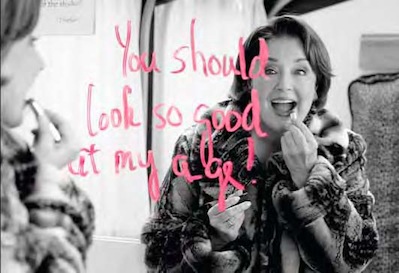Letting Go of the Body Myth
“I’m just trying to change the world one fat girl at a time,” Gabi Gregg ’08 writes in the Young, Fat, and Fabulous blog she’s been churning out since graduation. Gregg is determined to make a difference in the lives of disenfranchised women everywhere: “girls like me—the ones who are so in love with an industry that is, well, not so in love with us.”
Fashion isn’t for fat girls.

And yet there’s Gregg, decked out in urban chic, to-die-for shoes, and stylish bling—all designed to show off her curves. At twenty-four, Greggs pretty face, with her apple cheeks and radiant smile, has already graced the cover of Black Enterprise magazine. She’s been quoted in the New York Times and has appeared on “Good Morning America.” And last January, she won an online contest to become MTV’s first “TJ”—Twitter jockey, with a $100,000 contract.
Gregg’s triumph of self-acceptance is all the more remarkable when you consider that she once “hated shopping” and tried “dozens” of diets in high school. Like many women, she was plagued by the “body myth,” a term coined by psychologist Margo Maine. The problem, as Maine explains it, is that we’ve come to believe—wrongly—that “our self-worth and worth to others is based on how we look, what we weigh, and what we eat.”
Indeed, it’s hard for a woman to get through the day without encountering images of buff bodies and flawless faces—looks that 95 percent of us can never achieve. How can we not be disappointed at what we see in the mirror?
Even Mount Holyoke graduates—savvy, independent-minded women, many of whom are steeped in feminism—aren’t immune.”I am utterly baffled at how, despite my gaining a top-notch education from a college that teaches us how to be strong and empowered women, I still manage to put most of my self-worth into what someone else thinks of me,” writes account executive Catherine “Cat” O’Brien ’03 in a Facebook post.
And it’s a lifelong struggle. “You have to come to terms with yourself again and again,” observes Caroline Carlson Jorgensen ’97. “Aging is my recent issue—seeing lines on my face that weren’t there.” We didn’t become a weight-obsessed society overnight. Historians date the beginning of the “diet ethic” to the late nineteenth century, when Americans became more sedentary and rich foods more accessible. But in the last thirty years, says literary historian Elena Levy-Navarro ’87, editor of Historicizing Fat in Anglo-American Culture, standards have become more unattainable. A generation ago, fashion models weighed 8 percent less than the average woman; today, they weigh 23 percent less.
Meanwhile, the $60 billion “weight management” industry is taking our insecurities to the bank. Most weight studies are funded by pharmaceutical companies and other businesses that profit from our panic. Dismayed by our expanding waistlines, we are easy marks for “scientifically proven” weight-loss regimens, products, supplements, and surgeries that promise to melt off the pounds. When one “fix” doesn’t work, we become anxious and depressed, blame ourselves—and then try something else.
So how did Gabi Gregg manage to defy the body myth? She was probably born resilient. “Gabi’s always known what she wanted,” says her mother, Sharon. Gregg also credits MHC for helping her find her voice. “Being in an all-women’s environment empowered me,” Gregg says. “I didn’t go to class worrying about my body or what I was wearing.” The Internet played a vital role as well. “People underestimate how important social media and online connections can be. In high school, I began blogging about myself on LiveJournal.” In her first year at college, she met other “fatshionistas” online. “I became convinced I didn’t have to be the fat girl who wore oversized tees and sweats to cover up my body.”
Gregg also stands on the shoulders of other MHC alumnae—women like Mary Duffy-Guerrero ’66. As the daughter of a hypercritical mother who “kept herself thin on cigarettes and Dexedrine,” Guerrero was put on a scale every Saturday as long as she lived at home. She became a “problem eater” early in life. “I was either on a diet or counting calories or binging,” she says. In college, such things were not discussed. “The message was, you could be fat and get a PhD, but no one would love you and want to be with you.”

Mary Duffy-Guerrero ’66, an early plus-size model, later founded the first plus-size modeling agency-Big Beauties. Now sixty-five, she owns Fashion for the Rest of Us aimed at the fashion, beauty, and media-image needs of women over fifty.
After graduation, at 5′ 6″ and weighing 150 pounds, Guerrero landed a job posing for the first Jordan Marsh department store plus-size catalog. “It was a rush to become the woman who made 40 million large-size women feel good about themselves,” she says. She then parlayed her visibility into founding the first plus-size model agency—Big Beauties. “I was the un-Jane Fonda, the Eileen Ford of large sizes.”
“I started the business out of rage,” Guerrero recalls. “Strangers would come up to me, and say, ‘You’d be really beautiful if you’d lose weight.’ Magazines ran headlines like, ‘Will Fat Sally Go to the Prom?’ It’s the duty of any educated woman to do something about that.”
Three decades later, many are. At MHC, student athletes aren’t subjected to weigh-ins. Body image is openly discussed among students, coaches, and counselors. And students who are passionate about these issues can join EveryBody, a campus organization that fosters self-esteem and size acceptance. The goal, explains its first cochair, Amanda Braga ’10, is to “convey a message that is seldom said to women, which is to love your own body instead of striving to have someone else’s.”
The message is spreading nationally as well, thanks to increasingly vocal size-acceptance activists, authors, and health professionals. “The consequences of obesity have been greatly exaggerated,” says Ellen Perrella, head athletic trainer at MHC. Yes, sedentary people—who often are overweight as well—are plagued by health problems. But correlation isn’t causation. “It’s fitness that matters, not weight,” she says.
Having seen “no improvement” in the preoccupation with weight and body image during her twenty-seven-year tenure, Perrella concludes, “We need a revolution.” To be sure, we”re up against some mighty economic and societal forces. But as the second-wave feminists were fond of saying, “The personal is political.” Revolutions begin when we question the status quo and change our own attitude and behavior. “If we put our money, time, and energy into health, politics, or world peace, instead of into what we
look like,” says Perrella, “the results would be staggering.”
Here are some ways to reach a “revolutionary” goal—liking your body.
“Think more about maintaining the machine than the coat of paint.”
So says small-business attorney Freya Allen Shoffner ’76, who has struggled with a negative body image her whole life. She suggests avoiding the mirror and concentrating on how you feel. “Do you feel charming, interesting, engaging? Then you probably are, and the rest doesn’t matter.”
Gabi Gregg discovered a way to use the mirror for positive affirmation: “Stand in front of it every day and find one good thing about yourself.”
But don’t expect miracles. “Some days I feel great,” says Caroline Jorgensen, who writes about her daily ups and downs on her Morningside Mom blog. “Other days I feel that my leftover baby belly will never go away.” Her antidote: Staying active and on top of what she wants to accomplish in life, which boosts her self-confidence. “When you feel good about yourself inside, it works its way out.”
Understand where your negative self-messages come from.
Freya Shoffner had an impossibly beautiful mother, a “delicate” sister, and a grandmother who repeatedly described Freya as “heavy, big, and strong.” Kids beat her up just for being different. “By the time I got to college, I’d internalized their voices,” she says.
Now she tries to be kinder to herself. “How I describe my looks depends on whether I’m using the words my therapist trained me to recite—’tall, slender, and attractive’—or what’s in my head: ‘tall, heavy, odd-looking, and old-looking for my age.'” It has also been helpful to revisit her past. As a child she’d imagined herself as a “rhinoceros,” and was shocked when she recently looked at an old photo. “There I was, at age eight, in my brand new Girl Scout uniform. I was scrawny!”
Another way to hush the critical chorus is to find a body-image buddy—a fellow foot soldier with whom you can share war stories. Jorgensen found several when she blogged about her struggles. And Gabi Gregg says, “I still heavily identify with my community of plus-size followers.”
Find your set point.
From 40 percent to 80 percent of how you burn calories is determined at birth. Each of us has a set point—”the weight you maintain when you exercise moderately and listen and respond to your body’s signals of hunger and fullness,” says Ellen Perrella.
We also have a genetic blueprint for strength and flexibility. If two people do the exact same fitness regimen, their bodies will react differently because each has a different “thermostat,” says Jeanne Friedman, head crew coach at MHC.
Drop “diet” from your health strategies.
“Dieting is worse than the condition it’s supposed to cure,” says Perrella, noting that chronic dieters are eighteen times more likely to develop an eating disorder. “Dieting and binging go hand in hand,” she adds.
And diets often don’t work. In one review of thirty-one obesity-treatment studies, subjects lost 5 to 10 percent of their starting weight in the first six months, but most of them gained it back; and within four to five years many regained more than they’d lost. “When you deprive yourself of a basic need,” Perrella explains, “you learn not to trust your body, and it results in overcompensation.” The alternative is “attuned” eating, which means following your body’s cues—eating when hungry, stopping when full.
And many people who think they should diet are already in their own set-point range, which is another reason diets “fail.”
Exercise, but not to lose weight.
“We are never going to be happy if we just think about weight,” says Perrella. And while

Freya Allen Shoffner ’76, who has long struggled with a negative body image, advises looking inward. “Do you feel charming, interesting, engaging? Then you probably are, and the rest doesn’t matter.”
physical activity is essential, it’s easy to slip into a more-is-better mentality. “I don’t think we have a team at MHC that isn’t struggling with these issues,” she adds. “We’re worried about our athletes wanting to be too small. They know they need to be fit and strong, and at the same time they’re open to all the images society shows us.” Embracing the idea that fat and fit are not mutually exclusive, MHC promotes the Health at Every Size (HAES) philosophy, which centers on size acceptance, attuned eating, and adding physical activity to your everyday routine.
“Walk, dance, do what you love. Enjoy your body and what it can do, but don’t connect it with weight loss,” agrees Elena Levy-Navarro, who has yo-yoed between anorexia and obesity since college. “It’s so important to get out there and move.”
Hit ’em with your pocketbook. When you pour money into the weight -management industry, it’s like consorting with the enemy. Instead, reward enterprises that go against the cultural grain. Buy magazines that feature images of older women and plus-size models. Support responsible companies that diversify their ads, such as Dove’s “real women” campaign.
Our voices—and our dollars—matter, as Gabi Gregg has shown. In 2009, when she saw no other “plus-size girls” at a conference that brought together style bloggers and retailers, she organized her own fatshionista conference—a series of meet-and-greets to convince retailers that many fat girls also have fat wallets.
Mediate the messages.
The body myth “poisons” girls at younger and younger ages, says Perrella. “My ten-year-old daughter already wants six-pack abs.” Recent studies suggest that 50 percent of girls are unhappy with their bodies, and 80 percent of US teenagers have dieted. So when you pull up those tight jeans, don’t exclaim, “Oh my God, I need to go on a diet!” Instead, say something positive about yourself. Eat and exercise sensibly. Talk about what healthy bodies can do, not what they look like.
Most important, tell your daughters that they’re good, strong, brave, and beautiful just the way they are. And remind them, as Mary Duffy-Guerrero points out, “Mattel made Barbie, but God made us.”
—By Melinda Blau
This article appeared in the spring 2011 issue of the Alumnae Quarterly.
BUSTING THE BODY MYTH
For links to a five-step plan for “Combating Popular Media and Saving Your Health” and other positive-body-image material, visit alumnae.mtholyoke.edu/bodyimage.
March 30, 2012









